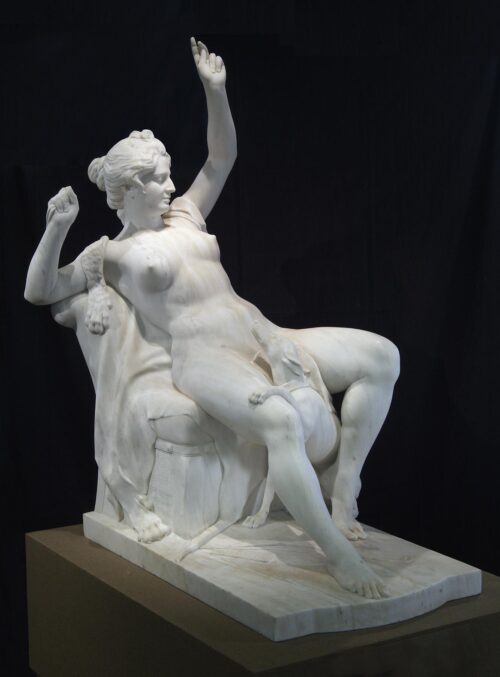
Bonanos Georgios (1863 - 1940)
Nana, 1896 - 1897
He first studied sculpture with Leonidas Drossis at the School of Arts (1876-1883) while also working at Dimitrios Filippotis’s workshop, and then with Antonio Allegretti and Girolamo Masini at the Rome Institute of Fine Arts; he also maintained his own workshop. In 1888, he settled in Athens, where he soon established a workshop, employing several assistants. In 1911, he was appointed professor at the Athens School of Fine Arts but immediately resigned because of disagreements with his colleagues and the Ministry of Education.
He presented his work in group exhibitions in Greece and other countries, including the Olympia in Athens (1888), Paris International Exhibition (1889) and Panhellenic exhibitions (1938 and 1939).
Georgios Bonanos lived during a period of transition for Modern Greek sculpture, when neoclassicist ideas survived in parallel with a trend towards realistic treatment. He employed the teachings of ancient Greek sculpture, which he considered his great model, as much as those of 19th-century neoclassicist masters, with whom he had become familiar during his studies in Rome; at the same time, he introduced a realistic style more evident in his choice of subject and less in treatment. Boasting of a broad range of subjects, he made a great number of statues, busts, funerary monuments and heroa, copies after ancient works, and non-commissioned works of free inspiration, characterized by their monumental qualities, harmony, measure, balance and assurance in composition.

Nana, 1896 - 1897

We use cookies to make our site work properly, to personalize content and ads, to provide social media features and to analyze our traffic. We also share information about how you use our site with our social media, advertising and analytics partners. Read the Cookies Policy.
These cookies are necessary for the website to function and cannot be switched off in our systems. They are usually only set in response to actions made by you which amount to a request for services, such as setting your privacy preferences, logging in or filling in forms. You can set your browser to block or alert you about these cookies, but some parts of the site will not then work. These cookies do not store any personally identifiable information.
If you disable this cookie, we will not be able to save your preferences. This means that every time you visit this website you will need to enable or disable cookies again.
These cookies tell us about how you use the site and they help us to make it better. For example these cookies count the number of visitors to our website and see how visitors move around when they are using it. This helps us to improve the way our site works, for example, by ensuring that users find what they are looking for easily. Our website uses Google Analytics for statistics reporting.
Please enable Strictly Necessary Cookies first so that we can save your preferences!